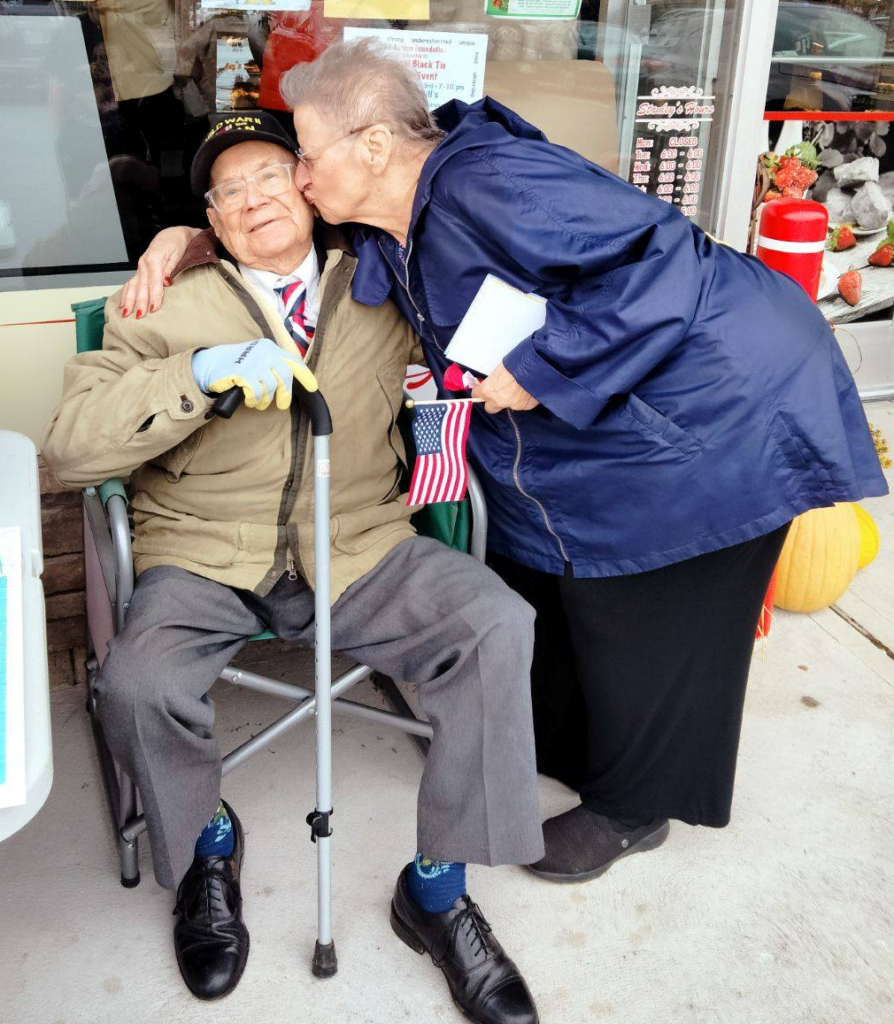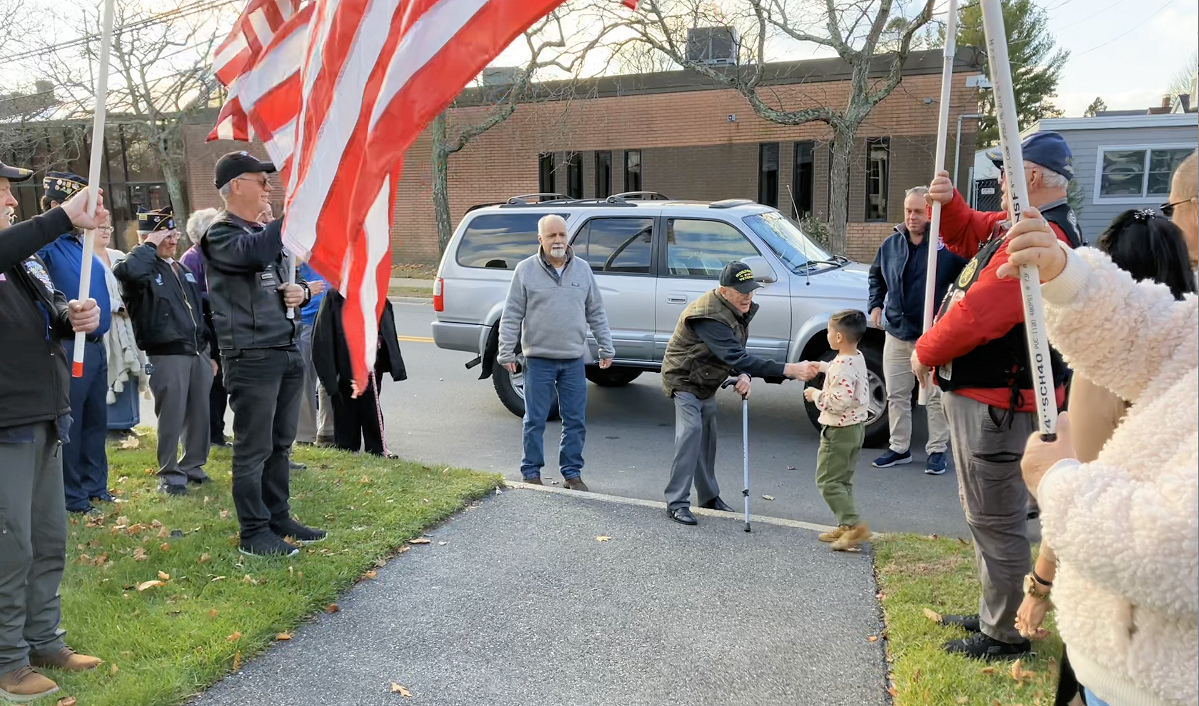By Matthew Stahl
A large contingent of extended family relations from around the country, along with Veteran associates of American Legion Rusy Bohm Post 411 in Islip, Vet-affiliated cycle riders, and Paws of War organization members, this date stood and cheered as a very special man arrived at a flag-waving, grand entrance celebration of his 99th birthday. Many fond reunions transpired as video tributes ran, awards were presented, and music by “Marty G and the G Men” lent elements of fun and atmosphere. Rich, personal stories were generously shared around the room, the latter of which the guest of honor abundantly accumulated through life both in and out of U.S. military service.
David Clarence Palmer, born November 27, 1925, in Norwalk, Connecticut, is the son of James Nathaniel Palmer, Sr., a multi-occupational father whose ancestry traces all the way back to the original Charlestown, Massachusetts, settlement and a ship that bore the name “Four Flowers” while accompanying the famed “Mayflower” on its fourteenth trek across the Atlantic. His Finnish mother, Tyrnni Ester (Laitenen) Palmer, emigrated to America as a teenager, learned English, became a United States citizen and went on to teach, tutor, and publish. Dave, second in line of a then eleventh generation Palmer family that grew to include two brothers and a sister, was raised in the village of North Stonington, Connecticut, where the troupe moved on guidance from a relative who surveyed the developing area.
The Palmer children shared several Connecticut homes in their growth years, one of which is now an official historical society site and another a still-standing family dairy farm that supplied the Hood Ice Cream Company. To assist his kin, Dave began working in the farm’s fields and driving tractors at the age of eight, when he could barely reach the control pedals. That acquired skill came to serve him well in later life. He graduated from Wheeler (High) School in 1943 and near immediately received a “welcome letter” of induction for U.S. Army service from Uncle Sam.
Dave went on to active-duty January 24, 1944. After reporting to Fort Devens, Massachusetts and completing basic training at Camp Landing, Florida, he attended signal school in Fort Benning, Georgia and was then assigned to the 71st Cavalry Mechanized Reconnaissance Troop of America’s Third Army, under the legendary command of General George S. Patton.
Palmer’s unit arrived at Le Havre, France, on February 6, 1945. Mr. Palmer functioned as a reconnaissance car crew member who performed dual roles as radio operator and driver, first in Willy’s military jeeps and later in gun carrying M-8 Greyhound armored cars. Designated drivers were awarded the privilege of naming their vehicles, and Dave tagged his assigned M-8 with the name “Reenie” after a long-secret, high school sophomore crush.
Once fully assembled, Dave’s division moved rapidly east to begin the ouster of German forces from France and saw its first combat action on March 11, 1945. By month’s end, it had stormed through outer belts of the Siegfried Line, captured the French town of Pirmasens and crossed the Rhine River into Germany after diversionary maneuvers at Oppenheim. The 71st then continued its relentless advance, taking Coburg without resistance, cutting the Munich-Berlin autobahn, and capturing Bayreuth after fierce opposition on April 16. Wheeling south, the division overpowered Schönfeld and Rosenberg, crossed the Naab and Danube Rivers and smashed through Regensburg and Straubing by April’s close. As resistance crumbled, the 71st Division crossed the Isar River and entered Austria May 2, 1945. They occupied defensive positions along the Enns River and contacted Russian forces east of Linz, Austria on May 8, just one day before hostilities ceased. As a fighting team, they had driven further east than any other U.S. Army unit deployed to the European Theater of Operations.
Sobering moments served to temper the celebration of victory. In the latter stages of their assaults, the 71st participated in liberating several Nazi concentration camps, most notably the Gunskirchen Lager sub-camp in Austria. The gruesome suffering, inhumanity, horror, and tragedy of what these G.I.s encountered on arrival was later detailed in an official government pamphlet entitled, “The Seventy-First came to Gunskirchen Lager.”
Recon units like the one to which Mr. Palmer was attached led the way in all these military exploits. Dave repeatedly found himself in the thick of things — at or near the front lines — throughout the previously described accountings of the 71st Division’s actions. His affectionately named armored chariot carried him 998 miles across France and Germany — all the way to the banks of the Steir River separating Europe from Russia – at speeds of up to sixty miles per hour on the German Autobahn.
While understandably reluctant to discuss many experiences along the way, Mr. Palmer has recounted details of a frantic retreat under heavy fire from advancing columns of German Panzer tanks and alerting other units in the direction of that advance to oncoming threats. He has also spoken of a chance scheduling change that saw the armored car crew that replaced his assigned patrol captured, and of single-handedly taking the surrender of a German soldier carrying a Panzerfaust anti-tank weapon — this while taking a “rest stop” in dense forest. Noteworthy is the fact that Dave TWICE sustained minor wounds in battle that qualified him for Purple Hearts but refused them on worry his mother back home might overreact when news reached her.
Personally witnessing the deplorable conditions under which Jewish internment camp prisoners were kept left forever marks on Dave’s soul, but a moving moment occurred years later when, by happenstance, he attended an Andrews Air Force Base show and fell into chat with a vendor whose own grandfather had survived his Gunskirchen Lager confinement — thanks to the timely arrival of Dave’s Army unit. The long-ranging, positive effect of service in an otherwise terrible war was spotlighted at that moment, as both parties to the conversation realized they would not be speaking had circumstances been different.
Dave separated from service on November 27, 1946. During his tour before discharge, he rose from the rank of private to Technician 5th grade and earned the title of Expert Rifle and Carbine Gunner. For commendable contributions to the war effort, he was awarded a Good Conduct Medal, European African Middle Eastern Theater Campaign Ribbon, Army Occupation Medal, Germany Victory Medal and World War II Victory Medal (Approved by Congress in 1948). After two years, four months and ten days full service, one year and three months spent deployed overseas and in combat zones, Dave received $300 in mustering out pay and $655 in advance travel compensation.
Post-war, this conquering hero returned home to North Stonington, Connecticut. He served work stints with the local road department and post office while studying forestry for a year at the University of Connecticut under the new G.I. Bill. Dave then relocated to Long Island, worked at his uncle’s Bay Shore boatyard for some time before marriage and came to join the Nassau County carpenters’ union, entering as a laborer and climbing his way up to job supervisor prior to retirement in 1990.
Dave met and married first wife Mildred Anna Setkowsky November 27, 1948. The couple took up residence in Bay Shore before purchasing land on Amuxen Court in Islip, right down the block from what would become his future American Legion Post. He personally built his new family home on that site with help from friends and family. Mr. and Mrs. Palmer raised two daughters and a son (Patti Ann, Peggy Ester and David Clarence, Jr.) together before her passing in March 1982. In the late eighties, Dave remarried Pasqua Ester Piscopo Bernardis, who sadly has also passed.
Mr. Palmer joined American Legion Rusy Bohm Post 411 in June 1991. Over thirty-three years of exemplary participation, he has served in various official and committee positions and has received numerous Legion citations. Dave was deservingly appointed Grand Marshal for the Post’s Town of Islip’s Memorial Day parade in 2023. Surprisingly vim and keen of mind at ninety-nine years of age, he remains an active, contributing and very well-respected member of the Post – rarely missing patriotic ceremonies. He also maintains a long-term association with the Trinity Lutheran Church in Islip. Carpentry skills learned in life were repeatedly demonstrated in lasting volunteer reconstruction projects he helped perform at both locations. In testament to his vigor, Dave was occasionally spotted making repairs to the Post rooftop well into his eighties. His work products will continue to stand beyond his years.
Dave currently resides with his stepson, Patrick Bernardis, in East Islip. The current Dave Palmer clan today counts a total of eleven grandchildren, fourteen great grandchildren (with another on the way), and seven great-great grandchildren. Several more senior family members have or are serving in the Navy, Marine, and Air Force branches of the U.S. Armed Forces, complementing the family patriarch’s Army service and carrying on a family legacy of involvement in America’s birth, growth and protection that his daughter amazingly reports dates to King Philips First Indian War in 1676.
In closing, we note that Mr. Palmer is the SOLE remaining World War II Veteran attached to American Legion Rusy Bohm Post 411 to see combat in that conflict. It is for all of us to treasure, safeguard and preserve in spoken word and publication, the memories and deeds of America’s greatest generation. This piece serves as one younger Veteran’s contribution to that effort, and as small tribute to people like David Palmer, who exemplify the best of what ALL Americans can and should be.





